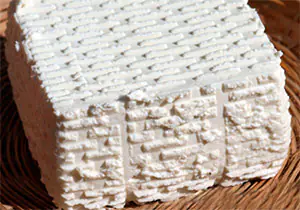We continue to study the masterpieces of world cheese making. Guest of our review today: Ricotta is a national cheese delight from Italy. Everyone talks about it as an ordinary, classic, solid, dairy product, but this is not true at all. If you read our article about the production process of classic milk cheese, you will see that it is made from whole or pasteurized milk. But Ricotta is prepared from whey, which, as you know, remains in the waste during the production of other types of cheese. But waste whey is directly related to milk, so Ricotta, to some extent, can still be called a cheese product.
Despite these unusual technological aspects of its preparation, Ricotta is very popular in Italy, other European countries, and throughout the world. It has a sweetish taste and low fat content of about 10-20% - this depends on the milk, after which whey remains. It turns out that after processing cow's milk, the fat content percentage is less than that of its analogue from goat's or sheep's milk whey. The whey is reheated, tartaric or citric acid is added to it, and after separating the curd clots, it is filtered, transferred into molds and left to mature. This is how we get the name of this high-protein food: literally – overcooked.
As you understand, such a low percentage of fat in a high-protein product makes it very attractive for bodybuilders, fitness models, in a word, for athletes who lead an active lifestyle, strictly monitor their appearance and adhere to a strict diet. Many famous bodybuilders are happy to include it in their diet. Of course, it is not cheap and has a very short shelf life, but all these disadvantages do not cover up its main advantages - a high percentage of protein with a minimum of fat, and this, as you know, is the best thing for bodybuilders!
The following varieties of Ricotta are distinguished:
- Baked (ricotta al forno).
- Matese (produced in Campania).
- Bruzza (produced in Liguria).
- Product from Santo Stefano d'Avento (cow's milk).
- Pugliese (a mixture of cow's and sheep's milk).
- Smoked (ricotta affumicata) from goat's milk.
- Fresh (ricotta fresca).
- Young with a slight sour taste - it is eaten spread on bread.
- Ripe (ricotta romana) - hard and salty.
In Italy, it is customary to add Ricotta cheese to almost all desserts. These include cakes, Neapolitan pies, pastries, pancakes and much more. After all, this type, unlike its counterparts, is fresh, not sour, similar in appearance to cottage cheese, but with a smoother structure. If you mix it with sugar, you will get wonderful cream and you don’t have to worry about preparing a full-fledged cream. In Italy it is difficult to find a housewife who would not use this whey milk product when preparing food.
However, in Russia, Ricotta has not received even a share of this popularity, with the exception of the above groups of people interested in dietary nutrition. After all, this cheese is extremely low in calories, enriched with protein, calcium and is well absorbed by the body. Another reason for not being so popular, as we previously mentioned, is the shelf life. You can rarely find it in Russian stores, as it is a highly perishable product. It can be smoked to extend its shelf life. And now the smoked variety is much more widespread in Russia. Grated smoked chips can be added to:
- lasagna,
- meat and vegetable pies,
- sauces,
- gravies.



